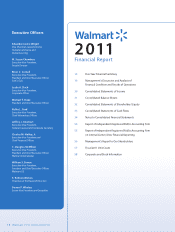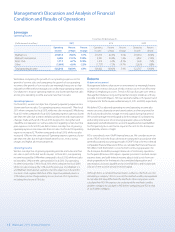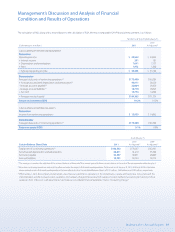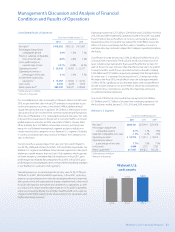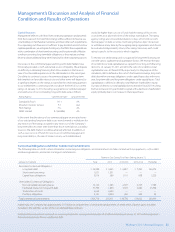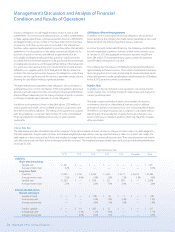Walmart 2011 Annual Report Download - page 18
Download and view the complete annual report
Please find page 18 of the 2011 Walmart annual report below. You can navigate through the pages in the report by either clicking on the pages listed below, or by using the keyword search tool below to find specific information within the annual report.
Management’s Discussion and Analysis of Financial
Condition and Results of Operations
16 Walmart 2011 Annual Report
Overview
Wal-Mart Stores, Inc. (“Walmart,” the “Company” or “we”) operates retail
stores in various formats around the world and is committed to saving
people money so they can live better. We earn the trust of our customers
every day by providing a broad assortment of quality merchandise and
services at every day low prices (“EDLP”), while fostering a culture that
rewards and embraces mutual respect, integrity and diversity. EDLP is
our pricing philosophy under which we price items at a low price every
day so our customers trust that our prices will not change under frequent
promotional activity. Our focus for Sam’s Club is to provide exceptional
value on brand name and private label merchandise at “members only”
prices for both business and personal use. Internationally, we operate
with similar philosophies. Our scal year ends on January 31 for our U.S.
and Canada operations and on December 31 for all other operations.
We discuss how the results of our various operations are consolidated
for nancial reporting purposes in Note 1 in the “Notes to Consolidated
Financial Statements.”
We intend for this discussion to provide the reader with information that
will assist in understanding our nancial statements, the changes in certain
key items in those nancial statements from year to year, and the primary
factors that accounted for those changes, as well as how certain accounting
principles aect our nancial statements. We also discuss certain per-
formance metrics that management uses to assess our performance. The
discussion also provides information about the nancial results of the
various segments of our business to provide a better understanding of
how those segments and their results aect the nancial condition and
results of operations of the Company as a whole. This discussion should
be read in conjunction with our Consolidated Financial Statements as of
January 31, 2011, and the scal year then ended and accompanying notes.
Currently, our operations consist of three reportable business segments:
(1) the Walmart U.S. segment; (2) the Walmart International segment; and
(3) the Sam’s Club segment. The Walmart U.S. segment includes the
Company’s mass merchant concept in the United States and Puerto Rico,
operating under the “Walmart” or “Wal-Mart” brand, as well as walmart.com.
The Walmart International segment consists of the Company’s operations
outside of the United States and Puerto Rico. The Sam’s Club segment
includes the warehouse membership clubs in the United States and
Puerto Rico, as well as samsclub.com.
Throughout this Management’s Discussion and Analysis of Financial
Condition and Results of Operations, we discuss segment operating
income and comparable store and club sales. The Company measures
the results of its segments using, among other measures, each segment’s
operating income, including certain corporate overhead allocations. From
time to time, we revise the measurement of each segment’s operating
income, including any corporate overhead allocations, as dictated by the
information regularly reviewed by our chief operating decision maker.
When we do so, the prior period amounts for segment operating
income are reclassied to conform to the current period’s presentation.
The amounts representing “Other” in the leverage discussion of the
Company Performance Metrics are unallocated corporate overhead items.
Comparable store and club sales is a metric which indicates the performance
of our existing U.S. stores and clubs by measuring the change in sales for
such stores and clubs for a particular period from the corresponding period
in the prior year. Walmart’s denition of comparable store sales includes
sales from stores and clubs open for the previous 12 months, including
remodels, relocations and expansions. Changes in format continue to be
excluded from comparable store and club sales when the conversion is
accompanied by a relocation or expansion that results in a change in
square feet of more than ve percent. Since the impact of this revision is
inconsequential, the Company will not restate comparable store and club
sales results for previously reported years. Comparable store and club
sales are also referred to as “same-store” sales by others within the retail
industry. The method of calculating comparable store and club sales varies
across the retail industry. As a result, our calculation of comparable store
and club sales is not necessarily comparable to similarly titled measures
reported by other companies.
In discussions of our consolidated results and the operating results of
our Walmart International segment, we sometimes refer to the impact
of changes in currency exchange rates. When we refer to changes in
currency exchange rates or currency exchange rate uctuations, we are
referring to the dierences between the currency exchange rates we use
to convert the Walmart International segment’s operating results from
local currencies into U.S. dollars for nancial reporting purposes. The
impacts of currency exchange rate uctuations are typically calculated
as the dierence between current period activity translated using the
current period’s currency exchange rates and the comparable prior year
period’s currency exchange rates, respectively. We use this method for
all countries where the functional currency is not denominated in the
U.S. dollar.
In connection with the Company’s new nancial system implementation,
we changed the level at which we apply the retail method of accounting
for inventory. The retrospective application of this accounting change
impacted both segment and consolidated operating income, as well as
consolidated net income for all comparable periods presented. See “Notes
to Consolidated Financial Statements,” Note 2. “Accounting Change.”
In addition, we reclassied certain revenue and expense items within
our Consolidated Statements of Income for nancial reporting purposes.
The reclassications did not impact consolidated operating income or
consolidated net income attributable to Walmart. All prior period amounts
have been reclassied to conform to the current period’s presentation.
The Retail Industry
We operate in the highly competitive retail industry in all of the countries
we serve. We face strong sales competition from other discount, department,
drug, variety and specialty stores, warehouse clubs, and supermarkets,
many of which are national, regional or international chains, as well as










